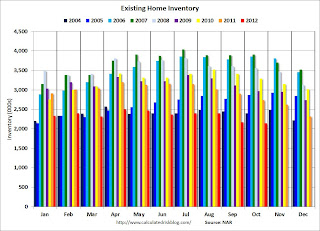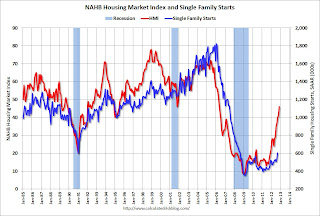by Calculated Risk on 11/19/2012 04:49:00 PM
Monday, November 19, 2012
Early: Housing Forecasts for 2013
Towards the end of each year I start to collect some housing forecasts for the following year. Here was a summary of forecasts for 2012. Right now it looks like new home sales will be around 365 thousand this year, and total starts around 750 thousand or so.
From Hui Shan, Sven Jari Stehn, Jan Hatzius at Goldman Sachs:
We project housing starts to continue to rise, reaching an annual rate of 1.0 million by the end of 2013 and 1.5 million by the end of 2016.Fannie Mae Chief Economist Doug Duncan is forecasting an 18.4% increase in housing starts in 2013 to 888 thousand, and single family starts increasing to 611 thousand.
Duncan projects new single family home sales to increase to 433 thousand from around 368 thousand this year. Duncan projects existing home sales will increase slightly to 4.76 million next year.
I'll be adding more forecasts, but I think we will see another solid percentage increase for housing starts and new home sales next year.
Existing Home Sales: A Solid Report
by Calculated Risk on 11/19/2012 12:35:00 PM
First, this report is a reminder that we have to be careful with the NAR data. The NAR revised down inventory for September from 2.32 million to 2.17 million (a downward revision of 6.5%). And the months-of-supply for September was revised down to 5.6 months from 5.9 months. These are very large revisions.
The percent distressed share (foreclosures and short sales) is also questionable. The NAR reported:
Distressed homes - foreclosures and short sales sold at deep discounts - accounted for 24 percent of October sales (12 percent were foreclosures and 12 percent were short sales), unchanged from September; they were 28 percent in October 2011.However this percentage is from an unscientific survey of Realtors, and other data suggests a larger decline in the share of distressed sales.
Oh well, I wish we had better data for the existing home market.
However, overall, this was a solid report. Based on historical turnover rates, I think "normal" sales would be in the 4.5 to 5.0 million range. So, existing home sales at 4.79 million are in the normal range.
Of course a "normal" market would have very few distressed sales, so there is still a long ways to go, but the market is headed in the right direction. The key to returning to "normal" are more conventional sales and fewer distressed sales. Not all areas report the percentage of distressed sales - that is why the NAR uses an unscientific survey - but the areas that do have shown a sharp decline in distressed sales, and a sharp increase in conventional sales.
Of course what matters the most in the NAR's existing home sales report is inventory. It is active inventory that impacts prices (although the "shadow" inventory will keep prices from rising). For existing home sales, look at inventory first and then at the percent of conventional sales.
The NAR reported inventory decreased to 2.14 million units in October, down from 2.17 million in September. This is down 21.9% from October 2011, and down 25% from the inventory level in October 2005 (mid-2005 was when inventory started increasing sharply). This is the lowest level for the month of October since 2001.
Important: The NAR reports active listings, and although there is some variability across the country in what is considered active, most "contingent short sales" are not included. "Contingent short sales" are strange listings since the listings were frequently NEVER on the market (they were listed as contingent), and they hang around for a long time - they are probably more closely related to shadow inventory than active inventory. However when we compare inventory to 2005, we need to remember there were no "short sale contingent" listings in 2005. In the areas I track, the number of "short sale contingent" listings is also down sharply year-over-year.
 Click on graph for larger image.
Click on graph for larger image.This graph shows inventory by month since 2004. In 2005 (dark blue columns), inventory kept rising all year - and that was a clear sign that the housing bubble was ending.
This year (dark red for 2012) inventory is at the lowest level for the month of October since 2001, and inventory is below the level in October 2005 (not counting contingent sales). Earlier this year I argued months-of-supply would be below 6 towards the end of the year, and months-of-supply fell to 5.4 months in October (a normal range).
The following graph shows existing home sales Not Seasonally Adjusted (NSA).
 Sales NSA in October (red column) are sharply above last year (there were 2 more selling days this year in October). Sales are well below the bubble years of 2005 and 2006.
Sales NSA in October (red column) are sharply above last year (there were 2 more selling days this year in October). Sales are well below the bubble years of 2005 and 2006.Earlier:
• Existing Home Sales in October: 4.79 million SAAR, 5.4 months of supply
• Existing Home Sales graphs
NAHB Builder Confidence increases in November, Highest since May 2006
by Calculated Risk on 11/19/2012 11:12:00 AM
I'll have some more comments on the Existing Home Sales report later this morning, but this is important too ...
The National Association of Home Builders (NAHB) reported the housing market index (HMI) increased 5 points in November to 46. Any number under 50 indicates that more builders view sales conditions as poor than good.
From the NAHB: Builder Confidence Rises Five Points in November
Builder confidence in the market for newly built, single-family homes posted a solid, five-point gain to 46 on the National Association of Home Builders/Wells Fargo Housing Market Index (HMI) for November, released today. This marks the seventh consecutive monthly gain in the confidence gauge and brings it to its highest point since May of 2006.
“While our confidence gauge has yet to breach the 50 mark -- at which point an equal number of builders view sales conditions as good versus poor -- we have certainly made substantial progress since this time last year, when the HMI stood at 19,” observed NAHB Chief Economist David Crowe. “At this point, difficult appraisals and tight lending conditions for builders and buyers remain limiting factors for the burgeoning housing recovery, along with shortages of buildable lots that have begun popping up in certain markets.”
...
Two out of three of the HMI’s component indexes registered gains in November. The component gauging current sales conditions posted the biggest increase, with an eight-point gain to 49 – its highest mark in more than six years. Meanwhile, the component measuring sales expectations for the next six months held above 50 for a third consecutive month with a two-point gain to 53, and the component measuring traffic of prospective buyers held unchanged at 35 following a five-point gain in the previous month.
All four regions of the country posted gains in their HMI three-month moving averages as of November. The South posted a four-point gain to 43, while the Midwest and West each posted three-point gains, to 45 and 47, respectively, and the Northeast posted a two-point gain to 31. (Note, the HMI survey was conducted in the two weeks immediately following Hurricane Sandy and therefore does reflect builder sentiment during that period.)
 Click on graph for larger image.
Click on graph for larger image.This graph compares the NAHB HMI (left scale) with single family housing starts (right scale). This includes the November release for the HMI and the September data for starts (October housing starts will be released tomorrow). This was above the consensus estimate of a reading of 41.
Existing Home Sales in October: 4.79 million SAAR, 5.4 months of supply
by Calculated Risk on 11/19/2012 10:00:00 AM
The NAR reports: Existing-Home Sales Rise in October with Ongoing Price and Equity Gains
Total existing-home sales, which are completed transactions that include single-family homes, townhomes, condominiums and co-ops, rose 2.1 percent to a seasonally adjusted annual rate of 4.79 million in October from a downwardly revised 4.69 million in September, and are 10.9 percent above the 4.32 million-unit level in October 2011.
...
Total housing inventory at the end of October fell 1.4 percent to 2.14 million existing homes available for sale, which represents a 5.4-month supply at the current sales pace, down from 5.6 months in September, and is the lowest housing supply since February of 2006 when it was 5.2 months. Listed inventory is 21.9 percent below a year ago when there was a 7.6-month supply.
 Click on graph for larger image.
Click on graph for larger image.This graph shows existing home sales, on a Seasonally Adjusted Annual Rate (SAAR) basis since 1993.
Sales in October 2012 (4.79 million SAAR) were 2.1% higher than last month, and were 10.9% above the October 2011 rate.
The second graph shows nationwide inventory for existing homes.
 According to the NAR, inventory declined to 2.14 million in October down from 2.17 million in September. Inventory is not seasonally adjusted, and usually inventory decreases from the seasonal high in mid-summer to the seasonal lows in December and January.
According to the NAR, inventory declined to 2.14 million in October down from 2.17 million in September. Inventory is not seasonally adjusted, and usually inventory decreases from the seasonal high in mid-summer to the seasonal lows in December and January.The last graph shows the year-over-year (YoY) change in reported existing home inventory and months-of-supply. Since inventory is not seasonally adjusted, it really helps to look at the YoY change. Note: Months-of-supply is based on the seasonally adjusted sales and not seasonally adjusted inventory.
 Inventory decreased 21.9% year-over-year in October from October 2011. This is the 20th consecutive month with a YoY decrease in inventory.
Inventory decreased 21.9% year-over-year in October from October 2011. This is the 20th consecutive month with a YoY decrease in inventory.Months of supply declined to 5.4 months in October.
This was slightly above expectations of sales of 4.74 million. For existing home sales, the key number is inventory - and the sharp year-over-year decline in inventory is a positive for housing. I'll have more later ...
LA Times: "Most aid from mortgage settlement in California going to short sales"
by Calculated Risk on 11/19/2012 08:41:00 AM
Update: Here is the national report: Continued Progress: A Report from the National Mortgage Settlement
From Alejandro Lazo and Scott Reckard at the LA Times: Most aid from mortgage settlement in [California] going to short sales
Short sales, which allow underwater borrowers to sell their homes for less than they owe, have become the dominant type of relief offered in California by the big banks, according to a report on the settlement expected to be made public Monday.Short sales were becoming more frequent prior to the mortgage settlement, but this is probably why short sales now out number foreclosures in many areas.
Under the settlement, banks were required to give homeowners aid in the form of principal reduction, short sales and other modifications. Banks get credit for both principal reductions and short sales under the agreement, but must give 60% of the relief nationally through principal reduction to families who keep their homes. ...
Through Sept. 30, the three banks had provided $8.4 billion, according to data from [UC Irvine law professor Katherine Porter's] office, putting them well on track to fulfill their obligations. About 68% of that money went toward providing short sales for homeowners. Principal reductions on first and second mortgages made up the rest of the California aid.


